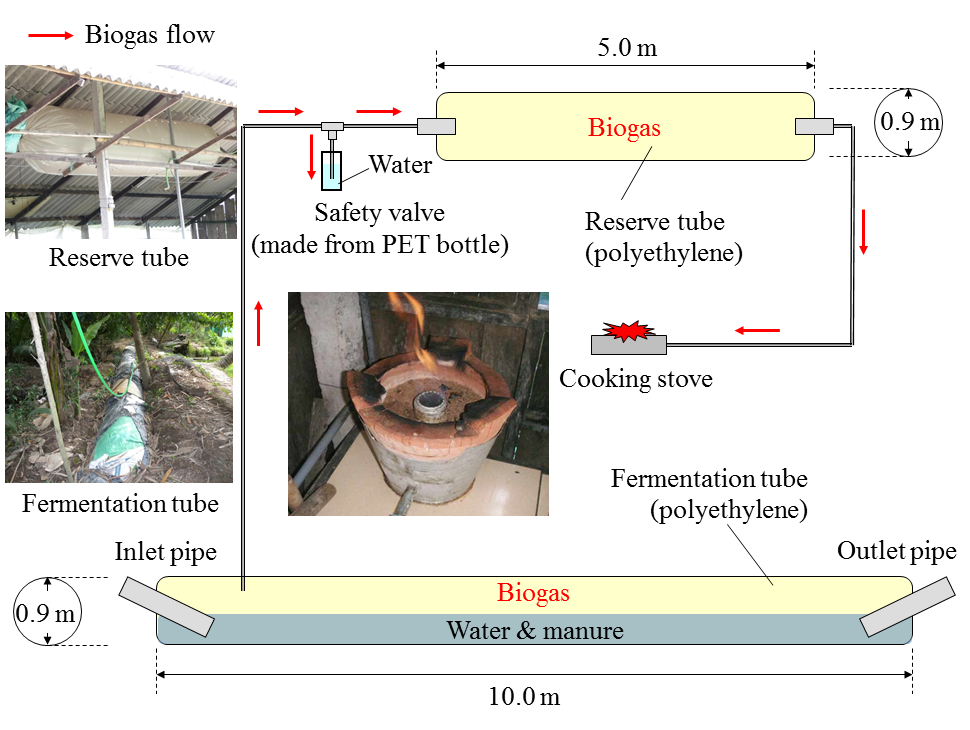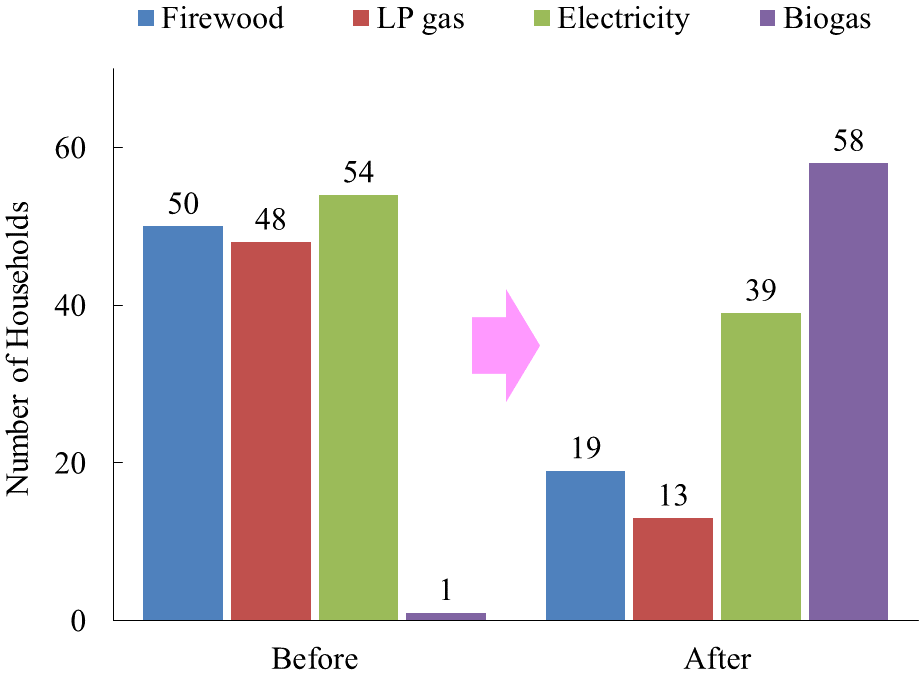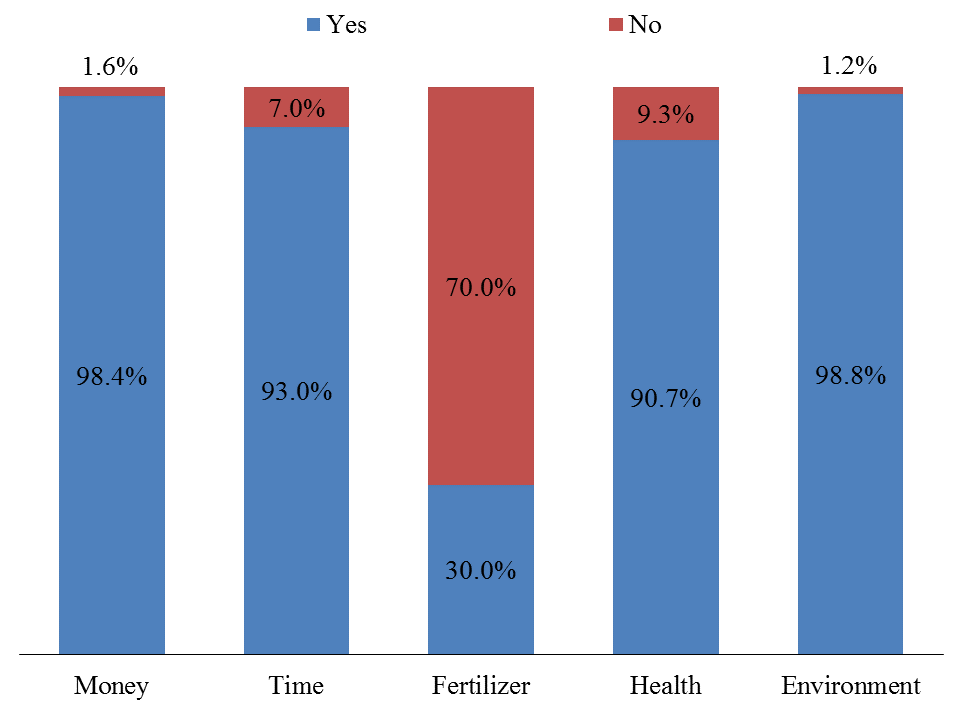Domestic biogas digesters reduce greenhouse gas emissions and provide benefits to households
Description
The Clean Development Mechanism (CDM) is an important instrument for reducing greenhouse gas (GHG) emissions because it provides for carbon offset projects in developing countries. However, this system is not working well due to the low price of carbon credits and so on. Thus, for the mitigation technology to be disseminated widely, it should be beneficial to households. The installation of domestic biogas digesters (BDs) using mainly livestock manure (Fig. 1) is one of the mitigation actions that can be applied at the household scale. This research, therefore, aims to clarify 1) whether BD is a measurable, reportable, and verifiable mitigation technology, and 2) whether BD realizes both mitigation and household benefits.
BDs were installed in 435 households in Mekong Delta, Vietnam, and the annual monitoring results (from 1 June 2013 to 31 May 2014) of biogas usage revealed that they used biogas for cooking on 95.7% of the total number of days. During this period, a total of 446 tCO2 of GHG were reduced by substituting conventional cooking fuel with biogas. This amount of reduction was verified and approved by the UNFCCC CDM Executive Board, and carbon credits were issued on 19 June 2015. This confirms that GHG emission is reduced by introducing BDs, and that it is a measurable, reportable, and verifiable climate change mitigation technology.
Introducing BDs reduced the amount of firewood and LP gas used (Fig. 2). GHG emission reduction and cooking fuel savings per household were estimated at 1.87 tCO2 and USD95, respectively, based on the annual changes in the usage amount of conventional cooking fuel (Table 1). Moreover, households that adopted BD technology benefitted financially. Questionnaire results indicated that more than 99% of households were satisfied with the introduction of BDs. Participating households also evaluated the effects of BD introduction, which included cost savings on cooking fuel, time savings due to less time spent on firewood collection, health benefits from avoiding smoke or soot generated by cooking with firewood, and environmental enhancements such as avoiding malodors and overcoming poor water quality issues (Fig. 3). The abovementioned results confirm that in addition to being a measurable, reportable, and verifiable mitigation technology for climate change, BD use also reduces greenhouse gas emissions and provides benefits to households.
The results of this research will form the basis of the suggestions that will be provided to the Vietnamese government when they try to realize their Intended Nationally Determined Contributions (INDC), which mentioned the use of biogas as among its GHG emission reduction strategies from the agricultural sector. Quantifying GHG emission reduction and household benefits derived by the installation of BDs depends on the amounts and types of cooking fuel used by the households prior to BD installation. The BD’s total initial cost is estimated at around USD180 (BD unit = USD140; labor = USD20; technical support = USD20), while maintenance cost is estimated at around USD20 per year. Considering the discount rate, the BD’s net present value during its useful life (about 7 years) can thus be calculated as more than USD200, which is nearly equal to two years’ worth of cooking fuel expenses for one household.
Figure, table
-
Fig. 1. Plastic biogas digester (BD) system
-
Fig. 2. Changes in cooking fuel usage before and after biogas digester (BD) installation
Note 1. Total number of surveyed households: 66
Note 2. Y-axis values refer to number of households that used each cooking fuel type during the study period
Note 3. One household used biogas digester (self-installed before project initiation) -
Table 1. Changes related to farm household cooking fuels before and after biogas digester (BD) installation (One household, Average of 66 households)
ItemBeforeAfterDifferenceAmount of cooking fuel usedFirewoodCooking1.590.32-1.27(t year-1)Pig feed1.500.38-1.12Total3.090.70-2.39LP gas (kg year-1)27.32.4-24.9GHG emissionsFirewoodCooking1.200.24-0.96Pig feed1.130.29-0.84(tCO2 year-1)Total2.330.53-1.80LP gas0.080.01-0.07Total2.410.54-1.87Expenses for cooking fuelFirewood (purchase)141-13Firewood (collection)5312-41(USD year-1)LP gas454-41Total11217-95Note. Survey on cooking fuel expenses was conducted based on Vietnamese currency (VND) and converted to US dollar using the exchange rate as of survey period (from 2012 to 2014). -
Fig. 3. Perceptions of participating households regarding the effects of biogas digester (BD) installation
Note 1. Number of surveyed households: 257
Note 2. Money = cost savings on cooking fuel; Time = time savings associated with reduced time spent on firewood collection and cooking; Fertilizer = use of BD effluent as fertilizer for gardens and ponds; Health = health benefits from avoiding smoke and soot generated from cooking by firewood; Environment = Environmental enhancement by reducing malodors and overcoming poor water quality issues.
- Affiliation
-
Japan International Research Center for Agricultural Sciences Rural Development Division
- Research project
- Program name
- Term of research
-
FY2016 (FY2011~FY2020)
- Responsible researcher
-
Izumi Taro ( Rural Development Division )
- ほか
- Publication, etc.
-
https://doi.org/10.5539/jsd.v8n8p147
Taro I et al. (2015) Journal of Sustainable Development, 8(8):147-158
https://doi.org/10.5539/jsd.v9n3p224Taro I et al. (2016) Journal of Sustainable Development, 9(3):224-235
UNFCCC (2015) Monitoring report ‘Farm household biogas project contributing to rural development in Can Tho City’ (version 02), Reference number 6132
https://cdm.unfccc.int/Projects/DB/JACO1335502236.58 - Japanese PDF
-
A4 410.33 KB
A3 304.09 KB
- English PDF
-
A4 1.42 MB
A3 811.46 KB
- Poster PDF
-
Poster 351.4 KB



